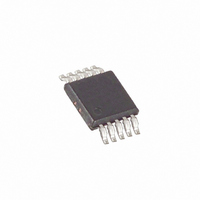MAX6650EUB+T Maxim Integrated Products, MAX6650EUB+T Datasheet - Page 20

MAX6650EUB+T
Manufacturer Part Number
MAX6650EUB+T
Description
IC REG FAN SPEED 10-MSOP
Manufacturer
Maxim Integrated Products
Datasheet
1.MAX6650EUBT.pdf
(25 pages)
Specifications of MAX6650EUB+T
Applications
Fan Controller, Brushless (BLDC)
Number Of Outputs
1
Voltage - Load
0.3 V ~ 5.2 V
Voltage - Supply
3 V ~ 5.5 V
Operating Temperature
-40°C ~ 85°C
Mounting Type
Surface Mount
Package / Case
10-MSOP, Micro10™, 10-uMAX, 10-uSOP
Operating Supply Voltage
3 V to 5.5 V
Lead Free Status / RoHS Status
Lead free / RoHS Compliant
Current - Output
-
Lead Free Status / Rohs Status
Lead free / RoHS Compliant
Other names
MAX6650EUB+T
MAX6650EUB+TTR
MAX6650EUB+TTR
Fan-Speed Regulators and Monitors
with SMBus/I
ware control. To enter full-on mode through hardware,
see the Setting Up the GPIOs section. Note that a hard-
ware full-on overrides all other modes.
Configure the MAX6650/MAX6651 to run in software
full-on mode by entering 00 into bits 5 and 4 of the con-
figuration register.
The full-off mode removes all the voltage across the
fan, causing the fan to stop. Because the MAX6650/
MAX6651 work by controlling the voltage on the low
side of the fan, either 5V or 12V will be on both leads.
Enter full-off mode by entering 01 into bits 5 and 4 of
the configuration register.
In open-loop mode, the MAX6650/MAX6651 do not
actually regulate the fan speed. Speed regulation
requires an external µC. Although open-loop mode
allows maximum flexibility, it also requires the most
software/processor overhead.
In open-loop mode, the MAX6650/MAX6651 act as an
SMB/I
the voltage across the fan by writing an 8-bit value to
the DAC register. This gives the µC direct control of the
voltage across the fan. Speed regulation is accom-
plished by periodically reading the tachometer regis-
ter(s) and adjusting the DAC register appropriately. The
DAC value controls the voltage across the fan accord-
ing to the following equation:
V
where V
= the supply voltage for the fan (5V or 12V), R2 = 90kΩ
(typ), R1 = 10kΩ (typ), V
the value in the DAC register.
Note several important things in this equation. First, the
voltage across the fan moves in the opposite direction
of the DAC value. In other words, low DAC values cor-
respond to higher voltages across the fan and therefore
higher speeds. Second, DAC values greater than 180
will result in 0V across a 12V fan. Similarly, DAC values
greater than 76 will produce 0V across a 5V fan. This
limits the useful range of the DAC from 0 to 180 for 12V
fans and 0 to 76 for 5V fans.
Remember that device tolerances can cause the output
voltage value to vary significantly from unit to unit and
over temperature. However, because this voltage is
within a closed speed-control loop, such errors are cor-
rected by the loop.
20
FAN
______________________________________________________________________________________
= V
2
C-controlled voltage regulator. The µC adjusts
256
FAN
FAN_SUPPLY
= the voltage across the fan, V
- [((R2) / R1) + 1] x V
REF
= 1.5V (typ), and K
2
C-Compatible Interface
REF
FAN_SUPPLY
Open Loop
x K
Full-Off
DAC
DAC
=
/
Below is a possible strategy for controlling the fan
under open-loop mode:
1) On power-up, put the device in open-loop mode with
2) Allow the fan speed to settle.
3) Read the TACH register to determine the speed.
4) Gradually increase the DAC register value (in steps
In open-loop mode, any one of the four tachometer regis-
ters (MAX6651) can be used to measure and regulate the
fan’s speed. This is especially useful in parallel fan sys-
tems where up to four fans will be controlled as one unit.
Care must be taken with this mode to prevent instabili-
ty, which can be caused by trying to update the fan
speed too often or in increments that are too large.
Instability can result in the fan speeding up and slowing
down repeatedly. Determining the proper update rate,
as shown in the following steps, depends largely on the
fan’s mechanical time constant and the system’s loop
gain (DAC step sizes):
1) Enter open-loop mode by setting bits 5 and 4 of the
2) Determine the speed of the fan(s) by reading the
3) Increase or decrease the DAC register to decrease
In closed-loop mode, the SMBus/I
µC) writes a desired fan speed to the MAX6650/
MAX6651, and the device automatically adjusts the
voltage across the fan to maintain this speed. This
operation mode requires less software/processor over-
head than the open-loop mode. Once the desired
speed has been written, the MAX6650/MAX6651 con-
trol the fan’s speed independently, with no intervention
required from the master. If desired, the MAX6650/
MAX6651 can be configured to generate an interrupt if
it is unable to regulate the fan’s speed at the desired
value (see Setting Up Alarms ). The MAX6650/MAX6651
can regulate only the speed of the fan connected to the
TACH0 input. Fans connected in parallel to the TACH0
fan will tend to run at similar speeds (assuming similar
fans). When going from full-off to closed-loop-mode, it
is recommended following this sequence:
1) Full-off mode
2) Full-on mode (with sufficient pause to initiate
3) Closed-loop mode
a DAC value of 00 (full speed).
of 1 or 2) until the desired speed is obtained.
control register to 11.
TACH register(s).
or increase the voltage across the fan, thereby
adjusting its speed.
movement)
2
C master (usually a
Closed Loop











